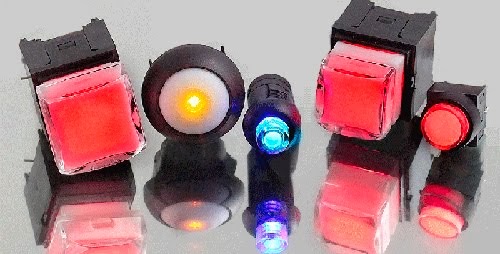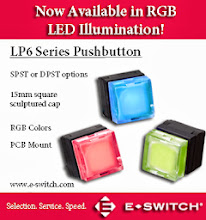| Electronic Switch Glossary of Terms |
|
|
Actuator: The mechanical interface between the basic switch contacts and the means of operation, such as the operator’s finger.
Actuation Force: The required force to change a circuit’s electrical state.
Alternate Action Switch: A Pushbutton style switch where the change of the electrical state is maintained between actuations.
Ampere: A unit of electrical current flow.
Base (Housing): A base of a switch is the main member to which the conducting parts or insulator unit are attached. It may also have parts of the operating or control mechanism attached.
Bounce: Rebounding of moving contact against fixed contact during transfer.
Break: Interruption of a circuit. Double-break occurs when a single mechanism interrupts two contacts simultaneously.
Break Before Make: The term given to a double throw switch where the first circuit is opened before the second circuit is closed.
Capacity: Usually refers to the current handling capability of a switch.
Chatter: Rapid opening and closing of contacts, usually exhibited during extreme vibration and/or shock.
Clearance (Spacing): Distance through air between electrically live parts of opposite polarity or to ground.
Contact: The contact is a conducting part designed to be united by pressure to another conducting part for the purpose of carrying current.
Contact Bounce: Oscillation of the movable contact upon closure of the circuit.
Contact Gap: The minimum distance between the fixed and moveable contacts.
Contact Resistance: The resistance of current flow across closed contacts.
Dead-Break: Open circuit condition, usually caused when slowly actuating snap-action switches. Results from low contact pressure or contact lift-off.
Detent: Feature that indicates actuation point has been reached. Can also be referred to as tactile feel.
Dielectric Strength: The ability of an insulating material to resist voltage from arcing across its surface.
Differential: Distance between trip point (or force) and reset point (or force).
Double-Break: A mechanism that breaks the circuit at two points simultaneously by means of a “shorting bar” like device.
Double-Throw: Contact arrangement that alternately transfers normally open and normally closed circuits.
Dust-Tight: Sealed switch will withstand sand and dust contamination.
Electrical Life: Expected cycle life when switch is operated at full rated load.
Free Position: Point at which plunger exists in the un-operated condition.
Insulation Resistance: The resistance to current flow of the insulating materials between contacts.
Lever Actuator: A device, hinged or spring type, applied to a basic switch to facilitate its application.
Make Before Break: The term given to a double throw switch when the second circuit is closed before the first circuit is opened.
Momentary Action Switch: The term given to a switch where a circuit is continuously closed or opened only when force is applied. The electrical state returns to its normal position when the force is removed.
Normally Closed: The term given to a switch where a circuit is closed in the normal switch position.
Normally Open: The term given to a switch where a circuit is open in the normal switch position.
Operating Point: Point at which contacts transfer. Usually measured from the switch mounting holes.
Over Travel: The distance an actuator travels after the circuit is closed.
Pole: The term to denote a completely separate circuit, which passes through a switch at one time.
Pre Travel: The movement of the actuator prior to closing the circuit. Sometimes identical to “Travel to Make”.
Reset Point: Point at which contact resumes normal position. Single-Break: Mechanism that transfers one contact.
Single Throw Switch: A single throw switch is a switch by means of which the circuit can be opened or closed by moving the switch blade into or out of one set of contacts only.
Snap Action: The abrupt transfer of contacts from one position to another. This action is relatively independent of the speed of actuator travel.
Splash Proof: Sealed switch will withstand heavy rain or stream of water.
Switch: A switch is a device for making, breaking, or changing the connections in an electric circuit.
Switch Abbreviations:
N.C.: Normally Closed circuit
N.O.: Normally Open circuit
SPST: Single Pole Single Throw
SPDT: Single Pole Double Throw
DPST: Double Pole Single Throw
DPDT: Double Pole Double Throw
MBB: Make Before Break
BBM: Break Before Make
Throw: The term denotes the number of positions in which a given pole is closed.
Travel to Make: The distance parallel to the designated direction of the actuator movement at which point a circuit is closed.
Watertight: Sealed switch will withstand submersion to various depths depending on specification level.
Wiping Action: Lateral travel of movable contact over fixed contact while pressure between the two contacts exists. Occurs during plunger travel. This action helps clean the contacts of contamination.







































